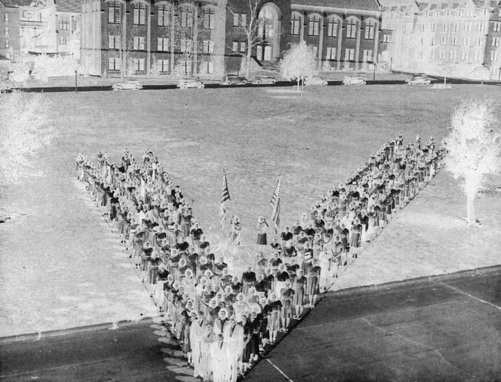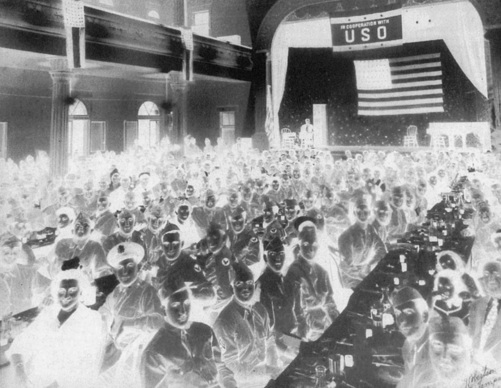The History of Florida (71 page)
Read The History of Florida Online
Authors: Michael Gannon
Tags: #History, #United States, #State & Local, #Americas

Sugar Corporation controlled 86 percent of the state market, although the
massive expansion of sugar production that created Big Sugar did not occur
until the postwar years. With the fall of the Philippines in 1942, U.S. Sugar
successful y lobbied the government to lift the domestic quotas on sugar
production.
The short- and long-term solution to Florida’s shortage of agricultural la-
borers came from afar. The U.S. Department of Agriculture (USDA) signed
340 · Gary R. Mormino
agreements with the governments of the Bahamas and Jamaica to allow the
temporary emigration of 75,000 workers, and to pay for their transporta-
tion. To planters and corporations, the policy was a godsend. L. L. Chandler,
chair of the Dade County USDA War Board, observed candidly: “The vast
difference between the Bahama Islands labor and the domestic . . . is that
the labor transported from the Bahama Islands can be deported and sent
home if it does not work.”10 The face—and faces—of Florida agricultural
work were changing.
What happened in Florida may have been a harvest of shame, but it was
also a harvest of plenty. The bittersweet truth remains: For all of the war’s
horrors, the conflict enriched the American home front. The war provided
Floridians, accustomed to decades of depression and scarcity, a taste of
prosperity and abundance.
City dwel ers were forced to come to terms with the dizzying changes
wrought by war. In September 1940, the
National
Municipal
Review
proph-
esied that American cities were threatened less by Stuka dive bombers than
by mounting crises in public health. Had the editor visited wartime Jackson-
ville, Miami, or Pensacola, he might have added alarming crises in public
education, urban services, and affordable housing.
World War II accelerated Americans’ mobile tendencies. Fifteen million
proof
Americans, in search of new opportunities, moved their residences and
workplaces between 1940 and 1945. Another 16 mil ion men and women
served in the armed forces, moving still greater distances. For most Ameri-
cans, the war was more
Odyssey
than
Iliad
. Florida cities functioned as dy-
namic hives of activity. Never static, the cities shuffled constant streams of
defense workers, rural migrants, tourists, and military personnel, who all
competed for scarce housing and transportation.
Jacksonvil e and Pensacola shared a symbiotic relationship with the
Georgia and Alabama hinterlands. Jacksonville drew large numbers of ru-
ral migrants from south Georgia. “Jacksonvil e came up in conversations
like the weather,” reminisced novelist Harry Crews, whose family left Bacon
County for opportunities in Florida.11 Pensacola’s “official” population in-
creased modestly, from 37,000 in 1940 to 43,000 in 1945. But these statistics
ignore at least 100,000 temporary residents who spent some time in the city.
Trailers and tents became commonplace as Pensacola groaned under the
burden of accommodating newcomers, many of whom spil ed into unin-
corporated areas.
In 1940, Key West slumbered as a colorful community of 13,000 resi-
dents. Five years later, 45,000 persons crammed the “Gibraltar of the Gulf.”
World War II · 341
It became, once again, a navy town, a home for PT boats, submarines, and
pleasure craft drafted into service. “War has brought about many changes
in Key West,” lamented the
Miami
Herald
in 1943. “One of the last of the
picturesque island’s customs to disappear was the closing of doors to stores
while a funeral procession passed. All business along the line of a funeral
procession must be suspended as a final tribute to the dead. But the war
ended that.”12 In what must have been the strangest conflict ever fought on
Florida soil or water, on 13 July 1943, a navy blimp and a German U-boat
engaged in battle forty miles south of Key West. Perhaps the most palatable
change was the completion of the long-awaited pipeline and aqueduct that
brought freshwater from an Everglades well field to Key West.
Miami hummed with the surging currents of war, as “the Magic City”
became a crossroads of travelers, workers, and soldiers. Tourists returned
to the city in 1943 when the county’s hotels returned to the business of plea-
sure. Official y, Miami’s population increased from 173,065 residents in 1940
to 192,122 in 1945. Unofficial y, the city’s population fluctuated wildly. In
January 1944, the
Miami
Herald
estimated the city was “home” to 325,000
persons, including winter visitors, soldiers, and visitors. “Except for the land
boom of 1925,” wrote journalist Nixon Smiley, “no other event in Miami’s
history had done so much to change the city as World War II. At the war’s
proof
beginnings Miami still had many of the qualities of a small town. As you
walked down Miami Avenue or Flagler Street you met person after person
you called by their first name. . . . The war changed all that.”13
Small-town Florida was not immune to wartime tumult. The
New
York
Times
’ Dora Byron toured Panama City, Ocala, and Homestead in the fall
of 1942. “Dime stores are thronged on Saturday night and churches filled on
Sundays,” Byron wrote. Pointing out the inevitable loss of community that
came with rapid growth, she stated: “Everywhere there is noise and hurry
and crowds. Al three quickly are strangers to smal Florida towns.”14 In
Stuart, older residents criticized improper wearing apparel, especial y “the
very short shorts and halter tops” of the new female residents shopping
downtown.15
Tal ahassee, a small community of 16,000 residents in 1940, felt the war’s
tremors. Over one-third of the city’s lawyers enlisted in the service. By 1944,
the Florida State Col ege for Women reached its largest enrol ment ever,
registering 2,227 students. On weekends, male students and soldiers from
Dale Mabry Field, Camp Gordon Johnston, and the University of Florida,
desperate for female companionship, descended upon the capital, many of
them forced to sleep in hotel lobbies and on park benches.

342 · Gary R. Mormino
President Doak Campbell (
foreground
) and student members of the Victory Club at
Florida State College for Women form a
V
for victory on the Tallahassee campus. The
students tilled “victory gardens” as part of the war effort.
proof
In big cities and rural hamlets, residents expressed in words and deeds
an outpouring of patriotic gestures and voluntary activities. Home-front
Florida recycled scrap metal, planted victory gardens, and rolled bandages
at the Red Cross. In Lakeland, the Florida Citrus Bomber Fleet Committee
raised funds to purchase fifteen Flying Fortresses. During one ral y, Pine
Island residents rescued ten tons of metal. In Zel wood, local children col-
lected tons of paper and scrap metal during assorted drives. Victory gar-
dens flourished. Floridians everywhere endured dimouts, gasless Sundays,
and ration coupons. In every community, a window flag bearing a blue star
meant a son in the military. A gold star signaled the somber news of a fam-
ily’s supreme sacrifice.
The col ective struggle to vanquish totalitarianism, leaders argued, bound
society together. While that proved true in part, the war’s dynamism also
created new fears and widened old fissures. War revealed how fragile unity
and patriotism were and how crises challenged democratic institutions. The
wartime struggle for racial justice, in particular, is il uminating. Inspired by
President Roosevelt’s call for “Four Freedoms,” and committed to defeating
World War II · 343
the evil empires of Japan and Germany, African Americans enthusiasti-
cal y joined in the fighting. The war instilled new hopes for change. African
American leaders championed a “Double V” campaign, supporting the war
against totalitarianism abroad while continuing the fight against racism at
home.
On the eve of Pearl Harbor, 515,000 African Americans resided in Flor-
ida. While Deep South states had hemorrhaged black migrants since 1915,
the Great Migration had affected Florida less severely. Many southern black
migrants had moved to places such as Jacksonvil e, Miami, and Tampa.
The “Second Great Migration,” begun during the war, only intensified that
pattern.
World War II represented the last American conflict fought with segre-
gated units. Daniel “Chappie” James, born in Pensacola in 1920, entered the
Air Corps and in 1975 became a four-star general. The famed Ninety-Ninth
Fighter Squadron, comprised of black fighter pilots, trained at Tal ahassee’s
Dale Mabry Field.
Nostalgia and distant memories depict the home-front war as a time
when al Americans came together. But competing visions of the Ameri-
can dream collided in Florida and the South. In the maelstrom of war, as
soldiers and civilians competed for services and respect, Floridians saw no
proof
reason to adjust the color line. A series of racial incidents stained Florida’s
wartime image, including melees involving black troops (especial y north-
ern-born servicemen) and white military police.16 In August 1942, the Fort
Myers City Council unanimously enacted an “emergency ordinance to de-
fine the customs which promote and preserve the inter-racial disorders.”
The ordinance made it unlawful for whites and blacks to “loiter upon the
streets” or to “patronize establishments serving food and intoxicating bever-
ages . . . [without respect to] the divisional areas set apart by long established
customs for colored and white occupancy and patronage.”17
Florida officials expected the worst. The State Defense Council and Army
Service Forces prepared a secret plan in the event of serious race riots at
Tal ahassee, Jacksonville, Orlando, St. Petersburg, Tampa, or Miami. “In the
City of Orlando,” the press release explained, “there is an undercurrent of
tension, activated by union organizers and the presence of Northern Negro
soldiers in the community.”18 Officials made plans to impose martial law in
the afflicted cities. Detailed maps indicated key neighborhoods and institu-
tions such as radio stations and newspaper offices.
The war forced some Floridians to confront racial boundaries. In 1943,
Herbert Krensky was traveling by train from Miami to Jacksonvil e. At a

344 · Gary R. Mormino
USO clubs throughout the state entertained the 2,122,100 servicemen and -women
who trained at Florida bases and camps. These GIs enjoyed a USO banquet at Tampa
proof
in April 1943.
stop in Ocala, a platoon of German POWs, dressed in their Afrika Corps
uniforms, boarded the train. “When our train stopped at Waldo,” remem-
bered Krensky, “we stopped for a moment. . . . On the platform were these
colored servicemen, one of them wounded and hobbling on crutches. They
tried to board with their tickets in hand. The conductor refused to let them
board. . . . He told them that since there were no colored coaches, that they
would have to ride in the baggage car.”19
The most sensational and horrifying racial episode occurred in Madison